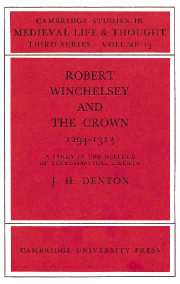Book contents
- Frontmatter
- Contents
- Preface
- Abbreviations
- Introduction
- 1 THE MAN: HIS LEARNING AND SANCTITY
- 2 EPISCOPAL COLLEAGUES
- 3 TAXATION AND POLITICS 1294–1296
- 4 TAXATION AND POLITICS 1297
- 5 TAXATION AND POLITICS 1298–1313
- 6 ROYAL CLERKS AND THE CURE OF SOULS
- APPENDIX: TABLE OF ROYAL TAXATION OF THE CLERGY 1294–1313
- Bibliography
- Index of manuscripts
- General index
APPENDIX: TABLE OF ROYAL TAXATION OF THE CLERGY 1294–1313
Published online by Cambridge University Press: 07 October 2009
- Frontmatter
- Contents
- Preface
- Abbreviations
- Introduction
- 1 THE MAN: HIS LEARNING AND SANCTITY
- 2 EPISCOPAL COLLEAGUES
- 3 TAXATION AND POLITICS 1294–1296
- 4 TAXATION AND POLITICS 1297
- 5 TAXATION AND POLITICS 1298–1313
- 6 ROYAL CLERKS AND THE CURE OF SOULS
- APPENDIX: TABLE OF ROYAL TAXATION OF THE CLERGY 1294–1313
- Bibliography
- Index of manuscripts
- General index
Summary
The amounts given in the following table are an approximation (more accurate for the subsidies based on the 1291 taxatio than for the lay subsidies) of the sums demanded of the clergy and are not based on collection returns. Where returns survive they suggest that the proceeds rarely fell far short of the amounts granted. Also, the collection of arrears resulted in a degree of levelling-out. The clergy's contributions to prises and to customs dues are impossible to calculate, and both are therefore excluded from consideration here.
All the papal tenths, a large percentage of which were paid to the king, and the direct clerical grants (with the exception of the tenth collected in 1298) were based on the 1291 assessment of the clergy's spiritual and temporal income by the order of Pope Nicholas IV. This taxatio assessed the annual clerical income of the English clergy at about £210,000, £170,000 of which was for the Canterbury province. These sums are the basis for the figures in the second and third columns of the table.
The taxes upon lay movables present a number of problems. Each tax was based upon a new assessment and thus requires a separate calculation. The totals for each assessment can be easily obtained, but there is no way of accurately determining the percentage of the total paid by the clergy. Even so, an estimate must be made, since the contribution of the clergy to taxes on lay movables is an important feature of royal taxation. Local assessment rolls, where they survive, give a guide, but no more than a guide.
- Type
- Chapter
- Information
- Robert Winchelsey and the Crown 1294–1313A Study in the Defence of Ecclesiastical Liberty, pp. 297 - 302Publisher: Cambridge University PressPrint publication year: 1980



